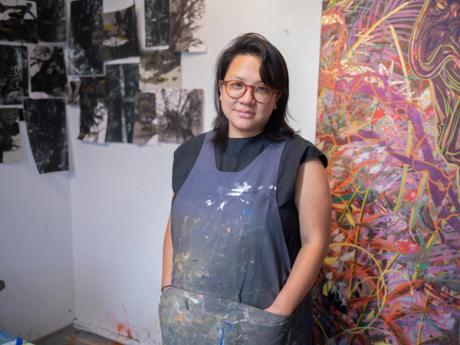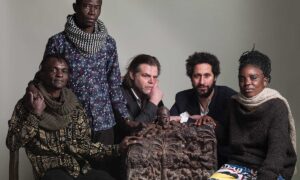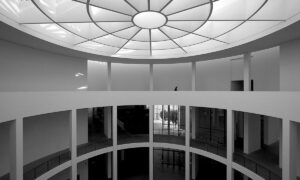
When multidisciplinary artist Tammy Nguyen talks about her work, she mentions “passages” a lot—both the topographical plats delineating her paintings, and the textual transitions she tackles in her book-making practice. In Nguyen’s estimation, history is not a straightforward narrative but a palimpsest of moments, at once muddled and searingly clear in its personal and political imprints. Nguyen’s parents arrived in the US as refugees after the American military’s withdrawal from Vietnam in 1975, and the spirit of diaspora has impacted her work since her time at Yale University’s MFA programme in the early 2010s. Her self-titled solo show at the Institute of Contemporary Art (ICA) in Boston boxes with the distinctly American specter of Ralph Waldo Emerson, father of transcendentalism and the cult of “self-reliance”, the utopian basis for some of his country’s cruelest bits of foreign policy. Emerson’s 1836 essay, “Nature”, elevates its subject to the realm of the divine, a portal to godliness achieved through thoughtful, masculine isolation. Nguyen’s acid-hued flora, however, encroaches on her canvases’ central figures—Emerson, Jesus, the Greek goddess of the harvest Demeter and and Ngô Đình Diệm, the final, ill-fated prime minister of South Vietnam—like an overgrowth of memory, a reminder of nature’s fierce, feral independence from the whims of whiteness.Tammy Nguyen positions the passage—from nation to nation, page to page, corner to corner of a frenzied composition—as a site of transformation where possibility, however dense or painful, can find footing. Her work doesn’t try to solve or condemn the scourge of imperialism; instead, she outlines its long shadow, adorning ambiguity in shiny flecks of diplomatic rupture. Nguyen’s visual language straddles cultures and identities. Her pieces at the ICA explore the grey underbelly of iconography, framing power as a mythic negotiation between chaos and perspective.Now based in Connecticut, Nguyen uses drawing, printmaking, painting and book arts to articulate complex geopolitical commentaries. She is the founder of Passenger Pigeon Press, an independent press that publishes cross-discplinary projects in science, journalism and art. She is represented by Lehmann Maupin and has shown at spaces across the world, including MoMA PS1 and the Rubin Museum in New York and the Factory Contemporary Arts Centre in Ho Chi Minh City. Nguyen spoke with The Art Newspaper about her ICA Boston show and the philosophy behind her “passages”.The Art Newspaper: You have a robust, multidisciplinary practice—you’re a bookmaker, a painter, you run a press. In the process of putting together a show like this, how do you choose which ideas become paintings? Which medium is the vessel for which concept?Tammy Nguyen: There are some ideas that lend themselves to becoming strong images and some ideas that don’t, which are much better as print works or as artists’ books. There have been times in the past where I think that there’s an idea for a painting and then I try it out as a singular image, but there’s too much context, so you need language, just regular old written sentences to grapple with what the images mean. Those paintings tend to not be able to hold the wall. So in this show, for example, the four big portraits—Emerson, Jesus, Demeter and Ngô Đình Diệm—are formally really strong images to explore.For a really long time I’ve been interested in how to confuse the space between figure and foreground, also portrait painting and landscape painting. How do you collapse those two? With the Emerson portrait, he’s sitting there with his hands resting on his knees— that whole internal belly area where his robes are flowing down—it’s such a beautiful passage. That’s a very different logic than thinking about, say, a passage in his essay, “Nature”, and how those passages might become a painting. Those passages, because they linger so much in philosophy and poetry, feel better to me as an artist’s book. Then the language is able to enter your body through your participation in it.Tammy Nguyen, Ralph Waldo Emerson, 2023 (Detail) Courtesy the artist and Lehmann Maupin, New York, Hong Kong, Seoul, and London.You centre Emerson’s “Nature” essay in this show. How are you conceiving of nature conceptually in the work?I have been interested in nature for a really long time, mainly thinking about how man has been able to extend his identity into nature through the ownership of property, through taming the land, etc. Those are such mighty and complex endeavours, like the endeavour of conquest, which is so ethically confusing. From an artistic standpoint, I’ve been really interested in using nature as a formal device to confuse the ideas of identity. When I was in grad school, I had just come back from living in Vietnam for four years, and I had started to think about colonialism for the first time. It wasn’t really something that had entered my intellectual orbit, but it started to enter while I was living there because it was so apparent all around me. And while it lived within me, being diasporic, I didn’t really know what to do with it while I was in grad school.A huge turning point for me was becoming a volunteer at the Yale Ornithology Library, where I learned how to do taxidermy. They have a programme there where you can volunteer to help to skin the birds, and then you can preserve the skins for scientists to study the feather distribution. It was a way for me to break out of this narrow tunnel of colonialism. I became engaged with the ways that some of the scientists around me were thinking, and that became the breeding ground for Passenger Pigeon Press. One thing leads to the next, and then I started to do a few research projects based on nature or inspired by nature, went back to Vietnam a couple of times with the intention of studying different parts of the Vietnamese landscape. It kind of just grew from there.When the ICA approached me with the proposition to do a solo show, I thought about the regional specificity. I have been interested in transcendentalism for a really long time, because when you simplify the philosophy, it’s extremely motivating to find your identity from within and to manifest it yourself. When you first learn about it, you’re not exactly burdened by ideas of “manifest destiny”. In addition to that, I think my first fictional role model was Jo from Little Women, and her family were all transcendentalist, so it was already there.Tammy Nguyen, Demeter, the Goddess of Harvest, 2023 Courtesy the artist and Lehmann Maupin, New York, Hong Kong, Seoul, and London.Could you talk about your stylistic choices and how they relate to the emotional geopolitics in your paintings?I like to think of formal elements—whether it’s colour, mark-making or signage—as being simultaneously emotive and symbollic. So for example, a particular colour of pink can be descriptive of a sunset, but it’s simultaneously provocative of a certain set of emotions. Those dualities that are intrinsic to the colour in a lot of situations that it might appear. In the show, the four portrait paintings are loosely representative of the four seasons of the Northeastern region. The Emerson painting is summer, the Vietnamese president painting is winter, Jesus is spring and then Demeter is fall. You figure this out through the artist’s books, but it’s not super obvious in the paintings.In the Demeter painting, the fall colours are pretty classic; oranges and purples and reds and stuff like that. However, the helicopters are red because they’re being submerged in this world that is filled with autumn and ideas about autumn, but that red is a very alarming red. It’s the red of an ambulance, the red of an alarm, of a siren and it’s also the red that is symbollic of blood. Now you’ve got these simultaneities happening, so you recognise that the helicopter is also a machine of war. One of the reasons I like using those particular helicopters so much is that from a distance, they almost look like a string of mosquitoes, and mosquitoes are so evocative of the tropics, but then when you zoom in, they become symbolic of this very particular time during the Cold War.I sometimes borrow from other people’s palettes as a way to historically anchor what I’m talking about. Two of the pieces reference Frederick Edwin Church paintings. I’m always thinking about tension. How do you take the palette of a sunset and sour it just a little? In music, there’s this chord called the “devil’s chord” that sounds like the moment before harmony resolves, and that’s how I’m trying to think about colour. I might surround a body with a whole bunch of cool blues and suddenly there’s like one warm blue that comes in to mess with the harmony of it a little bit. I’ll do that with every other area too. If an area of a painting is predominantly cold colours, I’ll strike it with the colour that’s a little bit hotter than normal.When you’re souring or pushing these otherwise expected or harmonious palettes, what reaction are you hoping for from the viewer? What is your relationship with viewers of your work?I really want to give as much as I can to the viewer. I hope that all my exhibitions and artwork is just giving and giving and giving to the viewer. I’m not really a fan of being opaque; I want to be generous to them and their time. In terms of thinking about the experience of the artwork, between the three different types of artwork that I make—artist books, works on paper and painting—each offers three different experiences.I want the paintings to be experiential and enthralling. I’m thinking about the viewer from 20ft away, from 15ft, 10ft and then slowly all the way up until their noses are up against it. I don’t think that I’m demanding folks find out about the histories; I want people to have their own poetic experiences with the paintings. It’s great if some of those interests align, but I don’t think it’s a necessity.The works on paper are a bit of a bridge from the world of painting into the world of artists’ books. The works on paper possess the kind of material poetics that is evident in the paintings, but bring in some of the didactic materials that I’m really interested in sharing—the information from the National Archive, the various folk songs that are being used, the old newspaper clippings. When you see things like that, I think that your way of reading the information is going to be inherently different than looking at a painting.On the other side of the spectrum, you’ve got the artist books. They’re not read in the way a conventional book is, but they’re poetic and informative. As the show comes together as this trinity, there are these multiple ways of reading and experiencing history that satiate your emotional desire and your intellectual curiosity.Tammy Nguyen, until 28 January 2024, Institute of Contemporary Art, Boston
























